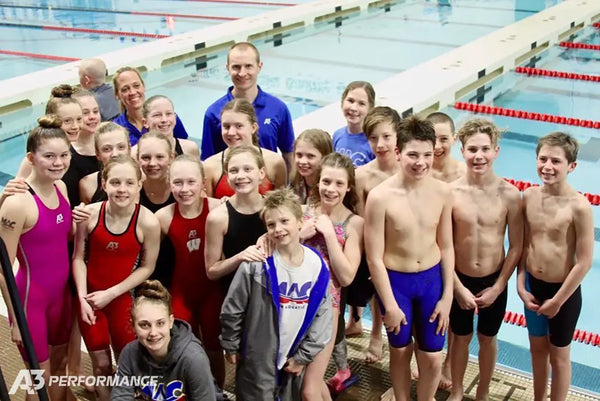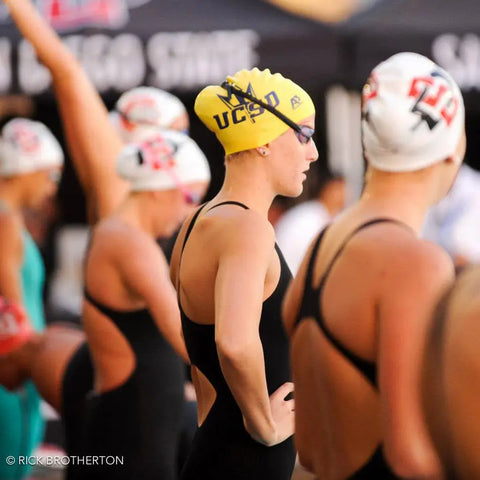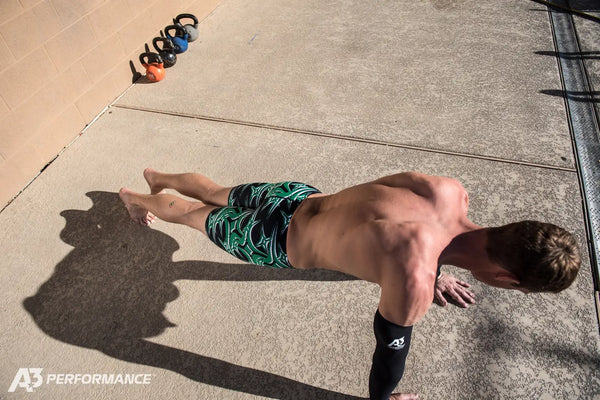Here is How Swimmers of All Levels Train (According to Coaches)
When you watch swimming on TV, the pros make pulling themselves through the water look effortless. However, I promise you, it is not as easy as it seems. Being even a high-school level swimmer can take years of training, dedication, and mental will-power. Want to find out what exactly goes into creating a champion swimmer? Read on to find out!
Swimmers Spend Hours Training Every Day
On average, swimmers train more than athletes in other sports. Most swimmers have morning practice 4-8 times per week. A swimmer’s day usually starts before the sun rises.
A high school swimmer’s practice generally begins around 5 am, while collegiate and professional swimmers usually have the luxury of starting at 6 am or 7 am.
After morning practice, swimmers have a few hours off. For swimmers still in school, those hours out of the pool usually consist of classes. After class comes afternoon swim practice, dinner, homework, and to bed to start it all over again in the morning.
Typical swim practice is grueling. A mile may seem like a lot to swim, but for a competent swimmer, a mile is usually a mere warm-up. A full practice can be anywhere between 3-8 miles depending on the type of practice, the time of the season, and the swimmer.
An average practice is usually two hours. The swimmer will start with a warmup. For many swimmers, this involves out of the water dynamic stretches for 5-15 minutes. After, they will jump in the water and warm up for 10-20 more minutes.
After the warm-up comes the pre-set. The pre-set helps swimmers to get ready for the main set; therefore, the pre-set will focus on whatever the main set of the workout focuses on. For example, if the main set is a backstroke set, the pre-set will focus on backstroke so the swimmer’s body is properly prepared to do backstroke.
After the swimmer has completed the pre-set, they move on to the main set. The main set is the central focus of the workout. Sometimes, there can be more than one main set. The main set is typically the hardest part of the swimmer’s practice. Oftentimes the main set can take well over an hour to complete.
Sets in swimming are repetitions of swims for time. For example, one set for a swimmer may be 5x100s on the 1:30. This means the swimmer will swim five times 100 yards or meters. Each 100 must be done faster than one minute and thirty seconds in order to make the interval. Remember that most sets are more complicated than this. They can include different distances and strokes. Sets can use equipment (more on this later) and sometimes the entire set is repeated multiple times.
Swimmers spend a lot of time working on technique. Proper technique allows the swimmer to move through the water with less effort. The best swimmers spend hours a week on their technique and are constantly trying to improve.
Swimmers also train their underwaters. Much of a swimmer’s race is completed underneath the water. A lot of practice time is spent working on lung capacity and underwater kicking.
After the workout is complete, the swimmer will cool down by swimming for at least five minutes straight. After they exit the water, they may stretch or use a roller.
Swimmers Train Differently Based On Their Level
Just like any sport, there are many different levels in swimming that require their own specialized way of training. Below are the different levels of swimmers and an overview of how each group trains.
Age Group Swimming
Age group swimming usually starts when swimmers are 5 to 6 years old and goes until they are 12. When swimmers begin age group swimming, they are expected to already know basic survival swimming skills. These swimmers start with working on technique and swim low amounts of yardage. The workouts gradually get longer and more complex as the swimmer grows and becomes more competent in the water.
Some swimmers progress at an early age and may start training at an advanced level. It is not uncommon for swimmers to add a second practice around the age of 11 or 12.
Club Swimming
Club swimming has many levels of its own. Most club teams have a variety of groups based on age and speed. Club swimming can be for the swimmer who only wants to attend a few practices a week or for the swimmer who wants to swim at high level meets. Many Olympians achieved their accomplishments through club swimming.
- High-level club swimmers usually practice multiple times per day and supplement their training with weightlifting or bodyweight exercises (more on this below).
- Club meets occur Thursday through Sunday. Swimmers have the opportunity to compete in a variety of events including almost every Olympic event.

Club swimming has two seasons: winter season and summer season. The winter season is short-course yards, meaning swimmers compete in pools that are 25 yards long (less than half the size of an Olympic pool). Summer season is long-course meters, meaning swimmers compete in pools that are 50 meters long (Olympic-size).
High School Swimming
High school swimming is a different organization than club swimming. It usually lasts 2-4 months during the school year and the time of year varies by state. In the past, high school swimming is known for having multiple hard practices a day and for pushing athletes to swim high levels of yards (it is less of a tendency nowadays).
- High school swimming has different meets than club swimming. High school has dual meets (meets between two schools) during the weekdays and invitationals (multiple schools) over the weekends.
- High school swimming does not include every event. Long-distance events are not offered and neither are 200s of stroke. However, the 200 and 500 freestyle is still a competition event.
- Although each state is different, most states have a regional competition at the end of the season. The best swimmers from each region will be invited to compete at the state meet.
Some swimmers choose not to partake in high school swimming and only do club swimming. However, most swimmers do high school swimming for a portion of the year and club swimming for the rest of the year
Collegiate Swimming
There are five different levels of college swimming: division one, division two, division three, NAIA, and NJCAA. Division one is the most prestigious and has the highest level of competition. Scholarships are offered to swimmers that would positively impact that college team. However, scholarships are harder to come by than most people expect.
- The best collegiate programs have the added benefit of nice facilities with lots of lane space. More space allows coaches to conduct more specialized practices; Swimmers are less crowded and are able to focus on their
 swimming technique.
swimming technique. - Collegiate swimming tends to be more individualized than club and high school swimming. Successful college programs usually have multiple coaches on deck who specialize in a different stroke/distance. Many practices involve splitting the team up into groups based on their best strokes or distance.
- Collegiate swim meets happen in short course yards (25-yard pools). Dual meets or double-dual meets (meets between three schools) are usually one day long and last between 2 and 6 hours.
- Invitationals occur over the weekend. They start either Wednesday or Thursday and go until Saturday. Multiple schools attend.
- At the end of the season, each conference will have their conference meet. After that, the top swimmers will be invited to compete at the NCAA, NJCAA, or NAIA meet. The division one NCAA meet is very fast and has Olympic level competition.
Professional Swimming
To be a professional in swimming means you have accepted an endorsement and are receiving compensation. Once you go professional, you cannot compete for a college/NCAA level. Some swimmers decide to give up the collegiate experience and go pro at an early age (like Michael Phelps). Others wait until after college and go pro once they have graduated (like Katie Ledecky).
Being a professional looks different for different people. Some choose to swim for their favorite club while others train with a college. Though this is rare, some professional swimmers don’t even have a coach and train themselves.
When they are not getting ready for the Olympics, most professional swimmers compete at high-level club meets like US Nationals or the Pro Swim Series
Masters swimming
Masters swimming is for adult swimmers. Many club teams offer master programs where the meets are broken into age categories. These age categories go all the way up to 100’s and continue in 5-year increments! Masters swimming is a great way for retired swimmers to stay in shape, remain competitive, and be a part of a swimming community.
Sprint vs Long-Distance Groups are Not the Only Swim Groups That Benefit From Individualised Training
At advanced levels, swimmers train differently based on what type of events they swim. Here’s a quick overview of the different types of swimmers and how they train:
- Sprinters - Sprinters swim short events, like the 50 or the 100. They usually train less yardage but higher intensity than other swimmers. Sprinters focus more on anaerobic training than aerobic training. It is common for sprint-oriented swimmers to focus on power and strength and may lift more often.
- Mid-Distance - Mid-distance swimmers compete in the 200 and 500 freestyle. They train more yardage than sprinters but less than distance swimmers. Mid-distance swimmers still focus on power, but aerobic training is a very important part of training for mid-distance.
- Distance - A distance swimmer specializes in the 500+ freestyle and trains the most yardage of any type of swimmers. They focus completely on aerobic swimming. It is not as important for distance swimmers to have a lot of strength and power. Their time is better spent building their aerobic capacity.
- Strokers - Strokers can be sprinters or mid-distance swimmers, but specialize in swimming a long-distance stroke other than freestyle (backstroke, breaststroke, butterfly). Strokers still train freestyle and all other strokes (to develop an aerobic base) but will spend a lot of their time swimming whatever stroke they are best at.
- IMers - Swimmers who compete in the IM (individual medley) either swim the 200 IM, the 400 IM, or both. These events are considered to be mid-distance. Unlike other swimmers, IMers need to train every stroke. They often train with strokers and switch strokes by day or have their own sets catered to the IM group. Most IMers will train approximately the same amount of yardage as mid-distance swimmers.
Swim Practices Change As the Season Progresses
Practices are modified at different times in the season. In the beginning, practices focus on building aerobic capacity and usually involve a lot of kick sets. This creates a strong foundation to build on during the rest of the season.
As the season progresses, practices will get more specialized. Each swimmer will focus on what they are best at. Not all practices are spent swimming, however. Some time is dedicated to improving skills like starts, turns, and underwaters.
At the end of the season, swimmers will enter what is called the “taper phase.” A taper is the time of the season when swimmers prepare for the main competition. Practices get shorter, weight training becomes less strenuous, and swimmers don't practice as often. This allows their muscles to recover in time for the big meet.
The amount of time a swimmer spends tapering is situational. Usually, it is between ten days and four weeks. Men need more time to taper than women and sprinters need more time to taper than distance swimmers.
Not enough taper means the swimmer may still be sore and tired at their peak meet. Too much taper is bad because the swimmer will be out of shape. Taper is a complicated topic, and it is up to the coach to find the perfect balance between too much and not enough taper.
Swimmers Also Train out of the Water
Swimmers don’t spend every minute of their practice in the water. Successful swimmers weight train and do exercises on land.
The type of land exercises the swimmer does depend on their level, age, and what they swim. Younger swimmers usually do not weight train. Instead, they do bodyweight exercises like squats, pushups, and planks. Most swimmers refer to this type of training as “dryland.”

Older swimmers will usually weight train. Swimmers typically hit the major muscle groups like back, shoulders, triceps, biceps, abdominals, quads, hamstrings, chest, and calves.
Advanced swimmers tend to be more specialized in their weight training. For example, sprinters typically lift more than distance swimmers because their events require more power. Also, sprinters will focus on lifting heavy weights with fewer reps while distance swimmers will lift lighter weights with more repetitions.
Aerobic exercises are great for swimmers. Many swimmers use the stationary bike as part of their workout. Though running is good for building aerobic capacity, it isn’t the best exercise for swimmers. Swimmers need flexible ankles and running builds muscle in the ankles that can limit flexibility.
Flexibility is the key to swimming fast. Swimmers need flexible shoulders, knees, and ankles. Many swimmers utilize yoga for this purpose.
In order to make weightlifting effective, swimmers need to eat properly. Read on to learn more about a swimmer’s diet.
Recovery Is Important for Swimmers of All Levels
To be a good swimmer, you must recover properly. Swimmers put their bodies through a lot and need to recover after each practice to get the most out of their bodies.
Recovery looks different for each swimmer. Stretching is common after every practice and helps relieve sore muscles and improve flexibility at the same time. Some swimmers also opt for ice baths or icing particular areas of the body that are sore.
Many elite swimmers see chiropractors or get massages on a regular basis. If a swimmer has an injury, they may also see a physical therapist or athletic trainer.
Compression Sleeves, like BODIMAX Sleeves from A3 Performance, are another great way to expedite your body's recovery post-training, pre-competition, while you're sleeping, and even during training. Do your research, though, because not all sleeves are the same. The BODIMAX Sleeves can be worn in the water, during training without breaking down. Compression technology is known to improve circulation and blood flow so waste like lactic acid is more easily and efficiently cleared from the muscles, which ultimately keeps muscles fresh, healthy, and performing at a higher level for longer.
In order for a swimmer to be successful, they have to eat right. Elite swimmers burn thousands of calories a day and need to replenish those lost calories.
Eating and hydrating properly is key to recovery. To maintain proper body composition, elite swimmers need to consume a lot more calories than the average person. A typical swimmer will ingest between 3,000 and 8,000 calories per day. The number of calories a swimmer needs daily is very individualized. Usually, the more yards a swimmer swims per day, the more they need to eat. Also, male swimmers will typically need to eat more than female swimmers.
Swimmers also need to eat large amounts of protein to build and repair muscle. Fruits and vegetables are just as important to deliver key nutrients. Swimmers should try to hit every food group in their meals.
Sleep is the most important component of the recovery process because it allows the body and mind to repair itself. Even though early practice times can make achieving an adequate amount of sleep difficult, swimmers must get a sufficient amount of sleep to optimize their training results.
As you can see, swimming is a complex sport with many categories of training. Training looks different for each swimmer and can be very individualized. We hope this article answered all of your swimming related questions! Be sure to look into our other articles On Deck!
